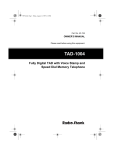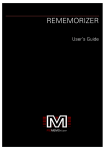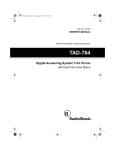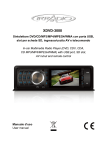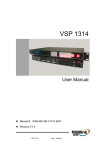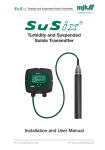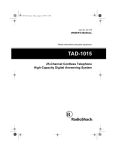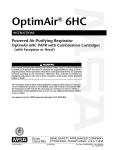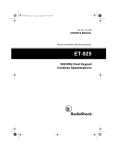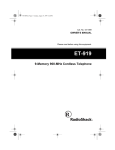Download Radio Shack TAD-1026 Owner`s manual
Transcript
43-786.fm Page 1 Monday, August 16, 1999 8:02 AM Cat. No. 43-786 OWNER’S MANUAL Please read before using this equipment. TAD-1026 Digital Answering System Telephone with Dual Announcements 43-786.fm Page 2 Monday, August 16, 1999 8:02 AM FEATURES Your RadioShack TAD-1026 Digital Answering System Telephone with Dual Announcements is a combination multifeature telephone and high quality answering system. Your TAD’s remote control feature lets you retrieve messages from almost any touch-tone phone. (With an optional pocket tone dialer, you can even use it from a rotary phone.) er’s message, or just playing an announcement without recording a message. And, when the TAD’s memory is full, it switches automatically to just playing an announcement. Digital means the TAD stores all messages on a computer chip — there are no tape mechanisms to wear out and no tapes to bother with. This gives you capabilities that tape-based answering machines don’t have. For example, you can delete individual messages. Two-Way Recording — lets you record both sides of your phone conversation. The TAD-1026’s 14-minute memory capacity lets you store a lot of messages. And, its unique, space-saving design makes it ideal for any office or nightstand. Voice Time/Day Stamp — announces the time and day when each message was recorded. Call/Message Counter — shows the current number of messages. Call Break-Through (CBT) with Programmable Code — alerts you when the caller enters a preset code during the outgoing message. Redial — dials the last number you dialed with the touch of a single button. Note: Your TAD-1026 requires a 9V battery for memory backup. Memory Backup — protects messages stored in memory in case of a power failure. Answering System Features ANSWER Button — lets you turn the answering system on or off. Dual Outgoing Message Capacity — lets you choose between playing an outgoing message then recording the call- DELETE Button — lets you quickly delete messages individually or all at once. © 1997 Tandy Corporation. All Rights Reserved. RadioShack is a registered trademark used by Tandy Corporation. 2 © 1997 Tandy Corporation. All Rights Reserved. RadioShack is a registered trademark used by Tandy Corporation. 43-786.fm Page 3 Monday, August 16, 1999 8:02 AM Toll Saver — lets you avoid unnecessary long-distance charges when you call by long-distance to check messages. Adjustable Ring Number — lets you set the TAD to answer the phone after two rings, four rings or seven rings. Call Screening — lets you listen while the caller leaves a message so you can decide whether or not to answer the call. Phone Pick-Up Detection — stops recording when you pick up any phone on the same line as the TAD (including the TAD’s handset), and resets to answer the next call. Memo Recording — lets you leave messages for yourself or others in your home or office. Room Monitor — lets you listen from a remote phone to the room where you installed the TAD. Remote On/Off — lets you turn the TAD on or off when you are away from your home or office. Telephone Features Priority Memory Dialing — lets you store a phone number in one of three memory locations and call that number with the touch of a button. 10 Indirect Memory Locations — let you quickly dial frequently-called numbers. Flash — sends an electronic switchhook signal for specialized telephone services such as Call Waiting. Privacy — lets you talk to someone else in the room without being overheard by the person on the phone. Pause — lets you store a pause in a memory number. TONE Button — lets you use computerized tone services with a pulse line. Hold — lets you put a call on hold; an indicator lights to remind you the call is on hold. Ringer Volume Switch — lets you adjust the ringer’s loudness or turn it off. Handset Volume Control — lets you adjust the handset’s volume. Hearing-Aid Compatibility — lets you use the phone with any hearing aid that has a T (telephone) switch. 3 43-786.fm Page 4 Monday, August 16, 1999 8:02 AM This TAD is ETL listed to UL standards and meets all applicable FCC standards. WARNING: To reduce the risk of fire or shock hazard, do not expose this product to rain or moisture. CAUTION RISK OF ELECTRIC SHOCK. DO NOT OPEN. ! CAUTION: TO REDUCE THE RISK OF ELECTRIC SHOCK, DO NOT REMOVE COVER OR BACK. NO USER-SERVICEABLE PARTS INSIDE. REFER SERVICING TO QUALIFIED PERSONNEL. ! If you are using more than one phone or other device on the line, add up all the RENs. If the total is more than five (or three in rural areas), your phone(s) might not ring and your TAD might not answer. If ringer operation is impaired, remove a device from the line. FCC STATEMENT This symbol is intended to alert you to the presence of uninsulated dangerous voltage within the product’s enclosure that might be of sufficient magnitude to constitute a risk of electric shock. Do not open the product’s case. Your TAD complies with Part 68 of FCC Rules. You must, upon request, provide the FCC Registration Number and the REN to your phone company. Both numbers are on the label on the bottom of the TAD. This symbol is intended to inform you that important operating and maintenance instructions are included in the literature accompanying this product. You must not connect the TAD to any of the following: READ THIS BEFORE INSTALLATION We have designed your TAD to conform to federal regulations, and you can connect it to most telephone lines. However, each device you connect to the phone 4 line draws power from the phone line. We refer to this power draw is the device’s ringer equivalence number, or REN. The REN is on the label on the bottom of the TAD. • Coin-operated systems • Party-line systems • Most electronic key phone systems 43-786.fm Page 5 Monday, August 16, 1999 8:02 AM CONTENTS Installation .............................................................................................................. 7 Installing the Backup Battery ............................................................................. 7 Selecting a Location .......................................................................................... 7 On a Desk Top ............................................................................................ 8 On a Wall Plate ........................................................................................... 8 Directly on a Wall ........................................................................................ 8 Connecting Power ............................................................................................. 9 Connecting the Handset Cord ........................................................................... 9 Setting the Dialing Mode ................................................................................... 9 Setting the Day and Time ................................................................................ 10 Setting the Ringer’s Volume ............................................................................ 11 Telephone Operation ........................................................................................... Setting the Handset Volume ............................................................................ Using REDIAL ................................................................................................. Using FLASH ................................................................................................... Using PRIVACY ............................................................................................... Using HOLD .................................................................................................... Using Tone Services on a Pulse Line .............................................................. Memory Dialing ............................................................................................... Storing a Number in Memory .................................................................... Entering a Pause ...................................................................................... Dialing a Stored Number .......................................................................... Testing Stored Emergency Numbers ........................................................ Chain-Dialing Service Numbers ................................................................ 12 12 12 12 13 13 14 14 14 15 15 15 16 TAD Operation ...................................................................................................... Recording the Outgoing Messages ................................................................. Setting the Number of Rings ........................................................................... Setting the TAD to Answer Calls ..................................................................... To Answer and Record ............................................................................. To Announce Only .................................................................................... Recording Incoming Messages ....................................................................... Screening Calls ............................................................................................... Playing Messages ........................................................................................... 17 17 18 18 18 18 19 19 19 5 5 43-786.fm Page 6 Monday, August 16, 1999 8:02 AM Deleting Messages .......................................................................................... Recording a Memo .......................................................................................... Recording a Conversation ............................................................................... Using Call Break-Through ............................................................................... Changing the CBT Code ........................................................................... Changing the Remote Operation Security Code ............................................. 20 21 21 21 22 22 Remote Operation ................................................................................................ 24 Remote Answer-On ......................................................................................... 24 Using Remote Commands .............................................................................. 25 Troubleshooting ................................................................................................... 26 Resetting the TAD ........................................................................................... 26 Care and Maintenance ......................................................................................... 27 The FCC Wants You to Know .......................................................................... 28 Lightning .......................................................................................................... 28 6 43-786.fm Page 7 Monday, August 16, 1999 8:02 AM INSTALLATION INSTALLING THE BACKUP BATTERY The TAD-1026’s answering system requires AC power to operate. However, if AC power fails or you unplug the TAD, a 9V backup battery (not supplied) saves the messages and the settings for the day, time, and security code. We recommend you use an alkaline battery, such as RadioShack Cat. No. 23-553. Caution: Always use a fresh battery of the required size and recommended type. Follow these steps to install the backup battery. 1. Use a Phillips screwdriver to remove the two screws on the battery compartment cover and remove the cover ment. A1, A2, CL, and 0 alternately appear. illustration 3. Replace the cover. When the battery is low and needs replacing, Lo appears on the display. Be sure the AC adapter’s cord is plugged in so you do not lose the TAD’s stored information, then replace the battery. Caution: Dispose of promptly and properly. old batteries MOUNTING THE TAD illustration 2. Snap the battery connector’s contacts firmly onto the battery, then place the battery into the compart- Select a location that is near both a modular telephone jack and an AC outlet. Your TAD connects directly to a modular phone line jack. If the jack is not a modular jack, you must update the wiring. You can convert the wiring yourself, using jacks and adapters available at your local RadioShack store. Or, you can let the phone company update the 7 43-786.fm Page 8 Monday, August 16, 1999 8:02 AM wiring for you. The USOC number of the jack to be installed is RJ11C, or RJ11W for a wall plate jack. Caution: The supplied adapter supplies 9 volts AC, delivers at least 400 milliamps, and has a plug which properly fits the TAD’s DC 9V jack. Using an adapter that does not meet these specifications might damage the TAD or the adapter. On a Desk Top Follow these steps when you place the TAD on a desk, shelf, or table. 1. Plug one end of the supplied long modular cord into the TEL.LINE jack on the back of the base. into the handset’s jack and place the handset on the TAD. 4. Insert the supplied adapter’s barrel plug into the DC 9V jack on the back of the TAD. Then plug the adapter’s other end into a standard AC outlet. DC 9V Jack illustration 4.epsi 2. Plug the modular cord’s other end into a modular phone line jack. 3. Plug one end of the supplied coiled cord into the jack on the left side of the TAD-1026. Plug the other end 8 When you first connect power, the TAD beeps once and the message counter counts up from 0 to 10. Then the TAD beeps. A1, A2, Lo, CL and 0 alternately appear to indicate that no outgoing messages are recorded, and the day/time stamp is not set. 43-786.fm Page 9 Monday, August 16, 1999 8:02 AM On a Wall Plate of the TAD. Then plug the adapter’s other end into a standard AC outlet. 1. Plug one end of the supplied short modular cord into the TEL. LINE jack on the top of the TAD. DC 9V Jack illustration 2. Route the cord into the groove on the phone’s base. 3. Position the phone’s base close to the wall plate and plug the other end of the short modular cord into the wall plate jack. 4. Align the wall plate studs with the TAD’s keyhole slots and slide the TAD downward to secure it. 5. Plug one end of the supplied coiled cord into the jack on the left side of the TAD-1026. Plug the other end into the handset’s jack. When you first connect power, the TAD beeps once and the message counter counts up from 0 to 10. Then the TAD beeps. A1, A2, CL and 0 alternately appear to indicate that no outgoing messages are recorded, and the day/time stamp is not set. 7. Slide the handset clip up and out of its retaining slot, rotate it 180°, then slide the clip back into its slot. Place the handset on the TAD. 7.epsi 6. Insert the supplied adapter’s barrel plug into the DC 9V jack on the top 9 43-786.fm Page 10 Monday, August 16, 1999 8:02 AM Directly on a Wall For this mounting method, you need two flat-head wood screws (not supplied) with heads that fit into the keyhole slots on the bottom of the TAD. 1. Drill two holes 315/16 inches (100 mm) apart. Then thread a screw (not supplied) into each hole letting the heads extend about 3/16 of an inch (5mm) from the wall. 3 /16 315 /16 When you first connect power, the TAD beeps once and the message counter counts up from 0 to 10. Then the TAD beeps. A1, A2, CL and 0 alternately appear to indicate that no outgoing messages are recorded, and the day/time stamp is not set. 7. Slide the handset clip up and out of its retaining slot, rotate it 180°, then slide the clip back into its slot. Hang the handset on the base. 7.epsi 2. Plug one end of the supplied long modular cord into the TEL. LINE jack on the top of the TAD. 3. Plug the cord’s other end into a modular phone line jack. 4. Align the two screws with the keyhole slots on the bottom of the TAD. Slide the TAD down onto the screws to secure the TAD to the wall. SETTING THE DIALING MODE 5. Plug one end of the supplied coiled cord into the jack on the left side of the TAD-1026. Plug the other end into the handset’s jack. Set T/P (tone/pulse) on the top of the TAD-1026 for the type of service you have. If you are not sure which type you have, do this test. 6. Insert the supplied adapter’s barrel plug into the DC 9V jack on the top of the TAD. Then plug the adapter’s other end into a standard AC outlet. 10 43-786.fm Page 11 Monday, August 16, 1999 8:02 AM 1. Set T/P to T. 11.epsi 2. Lift the handset and listen for a dial tone. 3. Press any number other than 0. Note: If your phone system requires that you dial an access code (9, for example) before you dial an outside number, do not press the access code either. Notes: • To avoid having to reset the time if AC power is lost, we recommend you install a backup battery before you set the day and time. See “Installing the Backup Battery” on Page 7. • If you do not complete each step within 8 seconds, the TAD stops setting and announces the day and time. Start again from Step 1. 1. Hold down STOP/T-SET until the TAD announces, “Sunday.” CL (clock) then 01 appear. 13.epsi If the dial tone stops, you have touch-tone service. Leave T/P set to T. If the dial tone continues, you have pulse service. Set T/P to P. SETTING THE DAY AND TIME The answering system records the day and time of the call with each phone message. Follow these steps to set the current day and time. Note: Adjust VOLUME on the right side of the TAD to the desired listening level. illustration 11 43-786.fm Page 12 Monday, August 16, 1999 8:02 AM 2. To change the day of the week, reMEMO to move peatedly press CODE to move forbackward or ward until the TAD announces the desired day of the week. SETTING THE RINGER’S VOLUME To adjust the ringer’s volume, set OFF.LO.HI to HI for a noisy room (such as a kitchen), or LO for a quiet room (such as a bedroom). 3. Press STOP/T-SET. The TAD announces the hour. 4. To change the hour, repeatedly MEMO to move backward press CODE to move forward to the or desired hour. 5. Press STOP/T-SET. The TAD announces the minute. 6. To change the minutes, hold down MEMO to move backward or CODE to move forward to the desired minute. 7. Press STOP/T-SET to confirm the settings. The TAD announces the day and time and CL disappears. To check the current day/time at any time, press STOP/T-SET. 12 If you do not want to be disturbed by a ringing phone, set the switch to OFF. The telephone does not ring, but you can make outgoing calls. If you hear an extension phone ringing, you can still answer incoming calls at this phone. 43-786.fm Page 13 Monday, August 16, 1999 8:02 AM TELEPHONE OPERATION Place and answer phone calls on the TAD-1026 as you would with any other phone. Read this section to learn about the phone’s special features. USING REDIAL You can quickly dial the last number dialed. When you hear a dial tone, simply press REDIAL. SETTING THE HANDSET VOLUME The handset’s volume control lets you adjust the sound you hear through the handset. This is especially helpful for persons who are hearing impaired or for poor phone lines or noisy areas. To increase the handset’s volume, set RECEIVER VOL to HI. If the volume is too loud, set RECEIVER VOL to LOW. Notes: • The redial memory holds up to 32 digits, so you can easily redial long distance as well as local numbers. • The redial memory does not store a FLASH entry or any keys you press after FLASH (see “Using Flash”). Note: To adjust the speaker volume, see “Screening Calls” on Page 21. 13 43-786.fm Page 14 Monday, August 16, 1999 8:02 AM USING FLASH person on the other end cannot hear you, but you can hear them. FLASH performs the electronic equivalent of a switchhook operation for special services, such as Call Waiting. Press PRIVACY again to resume your phone conversation. The indicator turns off. For example, if you have Call Waiting, press FLASH to answer an incoming call without disconnecting the current call. Press FLASH again to return to the first call. Note: If you do not have any special phone services, pressing FLASH might disconnect the current call. USING HOLD To temporarily put a call on hold without disconnecting it, press HOLD. The HOLD indicator lights. USING PRIVACY To talk with someone else in the room without the person on the other end of the phone hearing your conversation, press PRIVACY. The indicator lights. The HOLD Indicator Then do one of the following: • Hang up the handset. The call does not disconnect. 14 43-786.fm Page 15 Monday, August 16, 1999 8:02 AM To release the line from hold and continue your phone conversation, pick up the handset or another phone’s handset that is on the same line. • Hold the handset or set it next to the phone. To release the line from hold and continue your phone conversation, press and release FLASH or the phone’s switchhook. USING TONE SERVICES ON A PULSE LINE Some special services, such as bankby-phone, require tone signals. If you have pulse service, you can still use these special tone services by following these steps. MEMORY DIALING You can store emergency phone numbers or phone numbers you most frequently call in the three priority memory locations for one-touch dialing. You can store 10 more phone numbers in the indirect memory locations, then quickly call the number by entering its memory location number. Each memory location can store up to 16 digits. Storing a Number in Memory 1. Lift the handset. 2. Press STORE. 1. Be sure T/P is set to P. 2. Dial the service’s main number. 3. When the service answers, press TONE. Any additional numbers you dial are sent as tone signals. 4. After you complete the call, hang up the handset. The phone automatically resets to the pulse mode. 3. Enter the phone number you want to store. 15 43-786.fm Page 16 Monday, August 16, 1999 8:02 AM Notes: • If you make a mistake, hold down the switchhook for a few seconds. Then release the switchhook and begin again from Step 2. • You can store a FLASH entry in memory if it is the first entry. 4. Select the memory location as follows: • For a priority memory location, press STORE again, then press M1, M2, or M3. illustration • For an indirect memory location, press STORE, then enter the memory location number (0-9) where you want to store the number. A tone sounds to indicate that the number is stored. 5. For each stored number, pull out the supplied phone number index card from the bottom of the base and write the person’s or company’s name next to the appropriate loca16 tion number. (Use a pencil in case you need to change the number later.) 6. To store more phone numbers, return the handset to the cradle and repeat Steps 1–5 or press FLASH, then follow Steps 2–5. Entering a Pause In some telephone systems, you must dial an access code (9, for example) and wait for a second dial tone before you can dial an outside number. You can store the access code with the phone number. However, you must also store a pause after the access code to allow the outside line time to connect. To do so, press PAUSE . Each press enters a 2second pause. For a longer pause, press PAUSE additional times. 43-786.fm Page 17 Monday, August 16, 1999 8:02 AM Dialing a Stored Number Chain-Dialing Numbers To dial a number stored in memory, lift the handset and do one of the following: For a quick recall of numbers for special services (such as alternate long distance or bank by phone), store each group of numbers in its own memory location. • For priority memory numbers, press M1, M2, or M3 for the number you want to dial. • For indirect memory numbers, press MEMORY. Then press the one-digit memory location number (0–9) for the number you want to dial. To use the stored special service information, dial the service’s main number first. Then, at the appropriate place in the call, press MEMORY and the number for the location where the additional information is stored. illustration Testing Stored Emergency Numbers If you store an emergency service’s number (police department, fire department, ambulance) and you choose to test the stored number, make the test call during the late evening or early morning hours to avoid peak demand periods. Also, remain on the line to explain the reason for your call. 17 43-786.fm Page 18 Monday, August 16, 1999 8:02 AM ANSWERING SYSTEM OPERATION RECORDING THE OUTGOING MESSAGES 1. To record an OGM1 message, hold down OGM1 until the TAD beeps and A1 (Announcement 1) appears. Before you can set the TAD to answer calls and record messages, you must record the outgoing message (OGM) the caller hears when the TAD answers a call. The TAD-1026 lets you record two separate messages and it operates differently based on which message you select (see “Setting the TAD to Answer Calls” on Page 20). 22.epsi • OGM1 plays the message you recorded, and lets the caller leave a message of up to 60 seconds. • OGM2 (announcement only) plays the message you recorded, but hangs up without letting the caller leave a message. This is useful for announcing information about an upcoming event. Be sure the announcement clearly states that the caller cannot leave a message. If the TAD-1026’s memory becomes full, it will automatically switch from OGM1 to OGM2 and play OGM2 for any new calls. Note: The maximum length for each outgoing message is 32 seconds. As you record, the display counts down the remaining recording time. 18 To record an OGM2 message, hold down OGM2 until the TAD beeps and A2 (Announcement 2) appears. 23.epsi 2. Speak in a normal voice about 8 inches away from the microphone (located on the front of the TAD). If you are recording the OGM1 message, ask for the caller’s name, phone number, and message. 43-786.fm Page 19 Monday, August 16, 1999 8:02 AM Important: Do not tell callers that you are not home. Instead, say that you cannot come to the phone right now. 3. When you finish recording, press STOP/T-SET. The TAD automatically plays back the outgoing message. To play back your outgoing OGM1 message at any time, press OGM1. A1 appears, the TAD beeps, and the outgoing message plays. 2 — The TAD answers after two rings. 4 — The TAD answers after four rings. To play back your OGM2 message at any time, press OGM2, A2 appears, the TAD beeps, and the announcement-only message plays. SETTING THE NUMBER OF RINGS The ring select switch on the back of the TAD controls how long the TAD waits before it answers a call. Slide the switch to the appropriate position. 7 — The TAD answers after seven rings. T.S. (Toll Saver) — If there are new mes- sages, the TAD answers after two rings. Otherwise, the TAD answers after four rings. This lets you avoid unnecessary charges when calling by long-distance to check your messages. If you hear more than two rings, you know you can hang up because the TAD has no new messages. 19 43-786.fm Page 20 Monday, August 16, 1999 8:02 AM SETTING THE TAD TO ANSWER CALLS To Answer and Record To turn on the TAD-1026’s answering system and set it to answer calls and record messages, press ANSWER once. The TAD beeps, briefly displays On, and the ANSWER indicator lights. The TAD is now set to answer calls using the OGM1 message and record callers’ messages. 25.epsi The TAD is now set to answer calls using the OGM2 message without recording callers’ messages. To turn off the TAD-1026’s answering system so it does not answer calls, press ANSWER again. OF appears for a few seconds and the ANSWER indicator turns off. RECORDING INCOMING MESSAGES The maximum incoming message recording length is 60 seconds. When a recording reaches 55 seconds, the TAD beeps once to notify the caller that time will soon be up. When the recording reaches 60 seconds, the TAD sounds a long beep, then hangs up. The TAD hangs up and resets to answer the next call when: To Announce Only To turn on the TAD-1026’s answering system and set it to answer calls, but not record messages, press ANSWER so the ANSWER indicator lights. Then hold down ANSWER until the TAD beeps. Ao (announcement only) and the number of recorded messages alternately appear. 20 • The caller hangs up. • The maximum message length (60 seconds) is reached. • There are more than 8 seconds of silence. • You pick up any phone on the same line as the TAD (see “Screening Calls”). 43-786.fm Page 21 Monday, August 16, 1999 8:02 AM If the TAD’s memory is full (FL appears), the TAD answers the call after 8 rings and plays the announcement-only message (OGM2). PLAYING MESSAGES The display shows the total number of messages. If there are new messages, the power indicator also flashes until all new messages have been played. SCREENING CALLS To screen calls, let the TAD answer them, then listen to the caller’s message through the TAD’s speaker. If you decide to answer the call, pick up any phone on the same phone line as the TAD. The TAD stops recording and resets to answer the next call. Note: If you pick up the phone just as the TAD answers, the TAD might not stop playing the outgoing message. If this happens, press (on the keypad) or STOP/T-SET. If you do not want to take the call, do not pick up the phone, and let the TAD finish recording the caller’s message. To play all the messages (old and new), press PLAY. The TAD announces the number of messages recorded, each message number and the day and time the message was recorded, and then plays the message. To adjust the volume, slide VOLUME on the side of the TAD. 21 43-786.fm Page 22 Monday, August 16, 1999 8:02 AM To play only new messages, hold down PLAY for 2 seconds. (If there are no new messages stored, the TAD says, “You have no new messages.”) 29.epsi To adjust the volume, rotate VOLUME on the side of the TAD. After all messages play, the TAD says, “End of message(s)” and saves all the messages. To replay a message while you are lisMEMO. The current tening to it, press message starts again from the beginning. To resume playback, press PLAY again within 60 seconds. Otherwise, the TAD beeps twice, stops playback and displays the total number of messages. To stop playback at any time, press STOP/T-SET. The TAD beeps and resets To return to the previous message durMEMO twice. ing playback, press The previous recorded message plays. To skip to the next message during playCODE once. The next reback, press corded message plays. To pause while listening to messages, press PLAY. PS (pause) appears on the display. 22 to answer calls. DELETING MESSAGES To delete a specific message, press DELETE once while the message is playing. The TAD beeps once and dL (delete) briefly appears. The TAD deletes the current message, then plays the next. 43-786.fm Page 23 Monday, August 16, 1999 8:02 AM To delete all messages, hold down DELETE while playback is stopped. The TAD sounds a long beep and dL appears. The TAD deletes all messages except those that have not been played. RECORDING A MEMO A memo is a message you can record by speaking directly into the TAD, without having to call in on the phone. Follow these steps to record a memo up to 60 seconds long. MEMO . The TAD sounds 1. Press a long beep and 60 appears an begins a countdown to 0. Speak into the microphone in a normal voice. The display shows how much time is left for recording. 32.epsi The memo is stored along with the incoming messages. To hear the memo, simply play back your messages. RECORDING A CONVERSATION You can record both sides of a conversation on any phone connected to the same phone line as the TAD. Note: It is illegal in some areas to record a conversation without the consent of all parties to the conversation, including the phone company. Check the laws in your area before you use the two-way recording feature. MEMO until the TAD Hold down sounds a long beep. 2R (two-way recording) appears and recording begins. The TAD records until you press STOP/ T-SET, or there is 30 seconds of silence, or 8 seconds of a busy signal. 33.epsi 2. The TAD automatically stops recording after 60 seconds or you can press STOP/T-SET when you finish the memo. The TAD beeps once, and the message number indicator increases by one. 23 43-786.fm Page 24 Monday, August 16, 1999 8:02 AM To play back a recorded call, simply play back your messages. CODE until the TAD 1. Hold down beeps once. Co appears. USING CALL BREAKTHROUGH MEMO. Cc appears fol2. Press lowed by the digits of the preset CBT code in sequence, then the first digit reappears. If you screen your calls but want to be sure to know when calls come in from certain people, give those people your call breakthrough (CBT) code. Tell them to enter the code during the outgoing message. When a caller enters the CBT code, the TAD alerts you with two beeps, then it pauses for 40 seconds. Then the TAD sounds one beep every second for 5 seconds. To answer the call within the 45-second alert, pick up the handset. If you do not answer, the caller can leave a message after a long beep sounds. Note: CBT works only when you use the OGM1 message. Changing the CBT Code The CBT code is preset to 168, but you can change it by following these steps. Note: Be sure to set each digit within 8 seconds. Otherwise, you must start over from Step 1. 24 35.epsi For example, when the security code is 168, the display shows Cc, –1, –6, –8, then –1 reappears. CODE or 3. Repeatedly press MEMO to set the first digit, then press ANSWER. The second digit appears. Note: If you enter an incorrect digit, press STOP/T-SET, then start again from Step 1. CODE or MEMO to set 4. Press the second digit, then press ANSWER. The third digit appears. CODE or MEMO to set 5. Press the third digit, then press ANSWER. The TAD sounds a long beep. 43-786.fm Page 25 Monday, August 16, 1999 8:02 AM CHANGING THE REMOTE OPERATION SECURITY CODE The remote operation security code is preset to 784, but you can change it by following these steps. Note: Be sure to set each digit within 8 seconds. Otherwise, you must start over from Step 1. CODE until the TAD 1. Hold down beeps once. Co appears. Note: If you enter an incorrect digit, press STOP/T-SET, then start again from Step1. CODE or MEMO to set 4. Press the second digit, then press ANSWER . The third digit appears. CODE or MEMO to set 5. Press the third digit, then press ANSWER . The TAD sounds a long beep. To check the remote operation security code at any time, follow Steps 1 and 2, then press STOP/T-SET to exit. CODE again. Sc (security 2. Press code) and the digits of the current code appear in sequence, then the first digit reappears. 34.epsi For example, when the security code is 784, the display shows Sc (security code), –7, –8, –4, then –7 reappears. CODE or 3. Repeatedly press MEMO to set the first digit, then press ANSWER . The second digit appears. 25 43-786.fm Page 26 Monday, August 16, 1999 8:02 AM REMOTE OPERATION You can operate the TAD-1026’s answering system from almost any touchtone phone, or from a rotary phone using a pocket tone-dialer (available at your local RadioShack store). REMOTE ANSWER-ON Notes: To set the TAD to answer calls, dial your phone number. The TAD answers the call after 10 rings and sounds two beeps. • When the memory is full, the TAD answers the call after eight rings and plays the announcement-only message (OGM2). • To bypass the outgoing message and begin recording a message immediately when you call the TAD from a remote phone, you can press # during the announcement. The TAD skips the rest of the announcement, beeps once, and begins recording. • If the TAD is set to T.S. (toll saver), it answers after two rings if you have new messages (ones you have not played). If there are no new messages, the TAD waits for four rings before it answers. This gives you time to hang up before the TAD answers so you can avoid unnecessary long-distance charges. See “Setting the Number of Rings” on Page 19. 26 Note: An outgoing message must be recorded before you can remotely set the TAD to answer calls. Enter the remote operation security code within 8 seconds. The TAD sounds one long and one short beep and plays the OGM1 message. You can hang up at this point and the TAD is set to answer calls. Or, you can now enter other remote command(s). If the TAD records over 8 seconds of silence, it automatically disconnects. 43-786.fm Page 27 Monday, August 16, 1999 8:02 AM USING REMOTE COMMANDS To use the remote commands, you must enter the remote operation security code within 8 seconds after the TAD answers the call. After the TAD beeps once to verify you entered the code correctly, enter the number(s) for the function(s) you want the TAD to perform. Press: To: 00 Turn the answering system off. 01 Turn the answering system on. The TAD beeps and plays OGM1. (TAD is set to play OGM1.) 02 Set TAD to answer with OGM2 announcement. 2 Play all messages. 3 Play new messages. 4 Monitor the room where the TAD is installed. The room is monitored for 15 seconds. Press 4 again for another 15 seconds. You can repeat this for as long as you like. 51 Delete all messages (except new messages). 6 Stop playback and message recording. 7 Record a memo. Press: To: 81 Change OGM1. 82 Play OGM1. 91 Change OGM2 (after TAD is set to play OGM2). (Press 6 when finished.) 92 Play OGM2 (after TAD is set to play OGM2). #1 Change remote operation security code. #2 Change CBT Code. # Skip OGM1 during playback. After you press 2 or 3: Press: 5 To: Delete the current message. 1 while message number and day/ time is playing Replay the previous message. 1 during message playback Replay the current message. 3 Skip forward to the next message. 6 Stop message playback. 27 43-786.fm Page 28 Monday, August 16, 1999 8:02 AM TROUBLESHOOTING If you experience problems with your TAD, try the suggestions in this section. If you still have problems, contact your local RadioShack store for assistance. Problem The incoming message is incomplete. Remedy Be sure the memory is not full. The caller’s message was longer than 60 seconds. The caller was silent for over 8 seconds. The incoming message is unclear. Be sure VOLUME is set to the desired sound level. The TAD does not answer after two, Be sure the TAD is set to answer calls. four, or seven rings. Lo flashes on the display. The backup battery is weak. Replace the battery (see “Installing the Backup Battery” on Page 7). The TAD does not respond to the remote operation security code. Make sure the phone you used to dial the TAD is a touch-tone phone. Re-enter your remote operation security code, pressing each button for 2 seconds. The remote operation security code might have reset to the default code due to a power failure. Make sure the remote operation security code you entered is correct. No messages appear on the display. This could be caused by a power failure. Reset the TAD. You cannot record an incoming message. Be sure the TAD is set to answer calls. Be sure the memory is not full. RESETTING THE TAD If your TAD stops working properly, remove the AC adapter and the battery from the TAD, then reinstall them. Note: The outgoing messages and all information stored in memory are erased when you reset the TAD. 28 28 43-786.fm Page 29 Monday, August 16, 1999 8:02 AM CARE AND MAINTENANCE Your RadioShack TAD-1026 Digital Answering System Telephone with DualAnnouncements is an example of superior design and craftsmanship. The following suggestions will help you care for your TAD so you can enjoy it for years. Keep the TAD dry. If it gets wet, wipe it dry immediately. Liquids might contain minerals that can corrode the electronic circuits. Handle the TAD gently and carefully. Dropping it can damage circuit boards and cases and can cause the TAD to work improperly. Use and store the TAD only in normal temperature environments. Temperature extremes can shorten the life of electronic devices, damage batteries, and distort or melt plastic parts. Keep the TAD away from dust and dirt, which can cause premature wear of parts. Wipe the TAD with a damp cloth occasionally to keep it looking new. Do not use harsh chemicals, cleaning solvents, or strong detergents to clean the TAD. Modifying or tampering with the TAD’s internal components can cause a malfunction and might invalidate your TAD’s warranty and void your FCC authorization to operate it. If your TAD is not performing as it should, take it to your local RadioShack store for assistance. If the trouble is affecting the telephone lines, the phone company can ask you to disconnect your TAD-1026 until you have resolved the problem. 29 29 43-786.fm Page 30 Monday, August 16, 1999 8:02 AM THE FCC WANTS YOU TO KNOW In the unlikely event that your phone causes problems on the phone line, the phone company can temporarily discontinue your service. If this happens, the phone company attempts to notify you in advance. If advance notice is not practical, the phone company notifies you as soon as possible and advises you of your right to file a complaint with the FCC. Also, the telephone company can make changes to its lines, equipment, operations, or procedures that could affect the operation of this TAD. The telephone company notifies you of these changes in advance so you can take the necessary steps to prevent interruption of your telephone services. Your TAD complies with the limits for a Class B digital device as specified in Part 15 of FCC Rules. These limits provide reasonable protection against radio and TV interference in a residential area. However, your TAD might cause TV or radio interference even when it is operating properly. 30 To eliminate interference, you can try one or more of the following corrective measures: • Reorient or relocate the receiving radio or TV antenna. • Increase the distance between the TAD and the radio or TV. • Use outlets on different electrical circuits for the TAD and the radio or TV. Consult your local RadioShack store if the problem still exists. LIGHTNING Your TAD has built-in protection circuits to reduce the risk of damage from surges in telephone line and power line current. These protection circuits meet or exceed the FCC requirements. However, lightning striking the telephone or power lines can damage your TAD. Lightning damage is not common. Nevertheless, if you live in an area that has severe electrical storms, we suggest that you unplug the TAD during storms to reduce the possibility of damage. 43-786.fm Page 31 Monday, August 16, 1999 8:02 AM NOTES 31 43-786.fm Page 32 Monday, August 16, 1999 8:02 AM Limited One-Year Warranty This product is warranted by RadioShack against manufacturing defects in material and workmanship under normal use for one (1) year from the date of purchase from RadioShack company-owned stores and authorized RadioShack franchisees and dealers. EXCEPT AS PROVIDED HEREIN, RadioShack MAKES NO EXPRESS WARRANTIES AND ANY IMPLIED WARRANTIES, INCLUDING THOSE OF MERCHANTABILITY AND FITNESS FOR A PARTICULAR PURPOSE, ARE LIMITED IN DURATION TO THE DURATION OF THE WRITTEN LIMITED WARRANTIES CONTAINED HEREIN. EXCEPT AS PROVIDED HEREIN, RadioShack SHALL HAVE NO LIABILITY OR RESPONSIBILITY TO CUSTOMER OR ANY OTHER PERSON OR ENTITY WITH RESPECT TO ANY LIABILITY, LOSS OR DAMAGE CAUSED DIRECTLY OR INDIRECTLY BY USE OR PERFORMANCE OF THE PRODUCT OR ARISING OUT OF ANY BREACH OF THIS WARRANTY, INCLUDING, BUT NOT LIMITED TO, ANY DAMAGES RESULTING FROM INCONVENIENCE, LOSS OF TIME, DATA, PROPERTY, REVENUE, OR PROFIT OR ANY INDIRECT, SPECIAL, INCIDENTAL, OR CONSEQUENTIAL DAMAGES, EVEN IF RadioShack HAS BEEN ADVISED OF THE POSSIBILITY OF SUCH DAMAGES. Some states do not allow the limitations on how long an implied warranty lasts or the exclusion of incidental or consequential damages, so the above limitations or exclusions may not apply to you. In the event of a product defect during the warranty period, take the product and the RadioShack sales receipt as proof of purchase date to any RadioShack store. RadioShack will, at its option, unless otherwise provided by law: (a) correct the defect by product repair without charge for parts and labor; (b) replace the product with one of the same or similar design; or (c) refund the purchase price. All replaced parts and products, and products on which a refund is made, become the property of RadioShack. New or reconditioned parts and products may be used in the performance of warranty service. Repaired or replaced parts and products are warranted for the remainder of the original warranty period. You will be charged for repair or replacement of the product made after the expiration of the warranty period. This warranty does not cover: (a) damage or failure caused by or attributable to acts of God, abuse, accident, misuse, improper or abnormal usage, failure to follow instructions, improper installation or maintenance, alteration, lightning or other incidence of excess voltage or current; (b) any repairs other than those provided by a RadioShack Authorized Service Facility; (c) consumables such as fuses or batteries; (d) cosmetic damage; (e) transportation, shipping or insurance costs; or (f) costs of product removal, installation, set-up service adjustment or reinstallation. This warranty gives you specific legal rights, and you may also have other rights which vary from state to state. RadioShack Customer Relations, Dept. W, 100 Throckmorton St., Suite 600, Fort Worth, TX 76102 We Service What We Sell 3/97 RADIOSHACK A Division of Tandy Corporation Fort Worth, Texas 76102 9A7 Printed in China
































